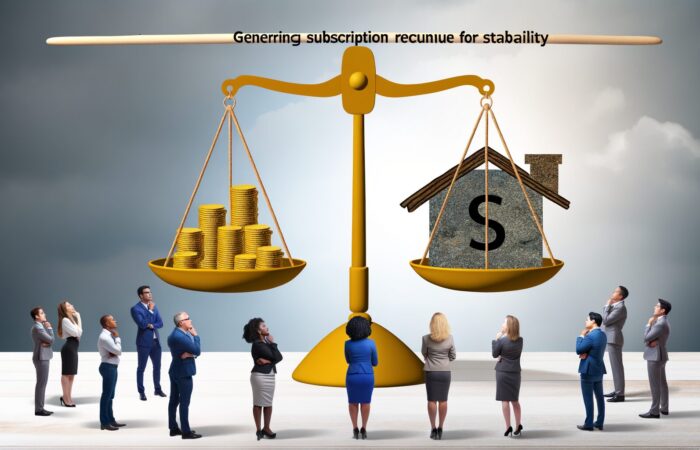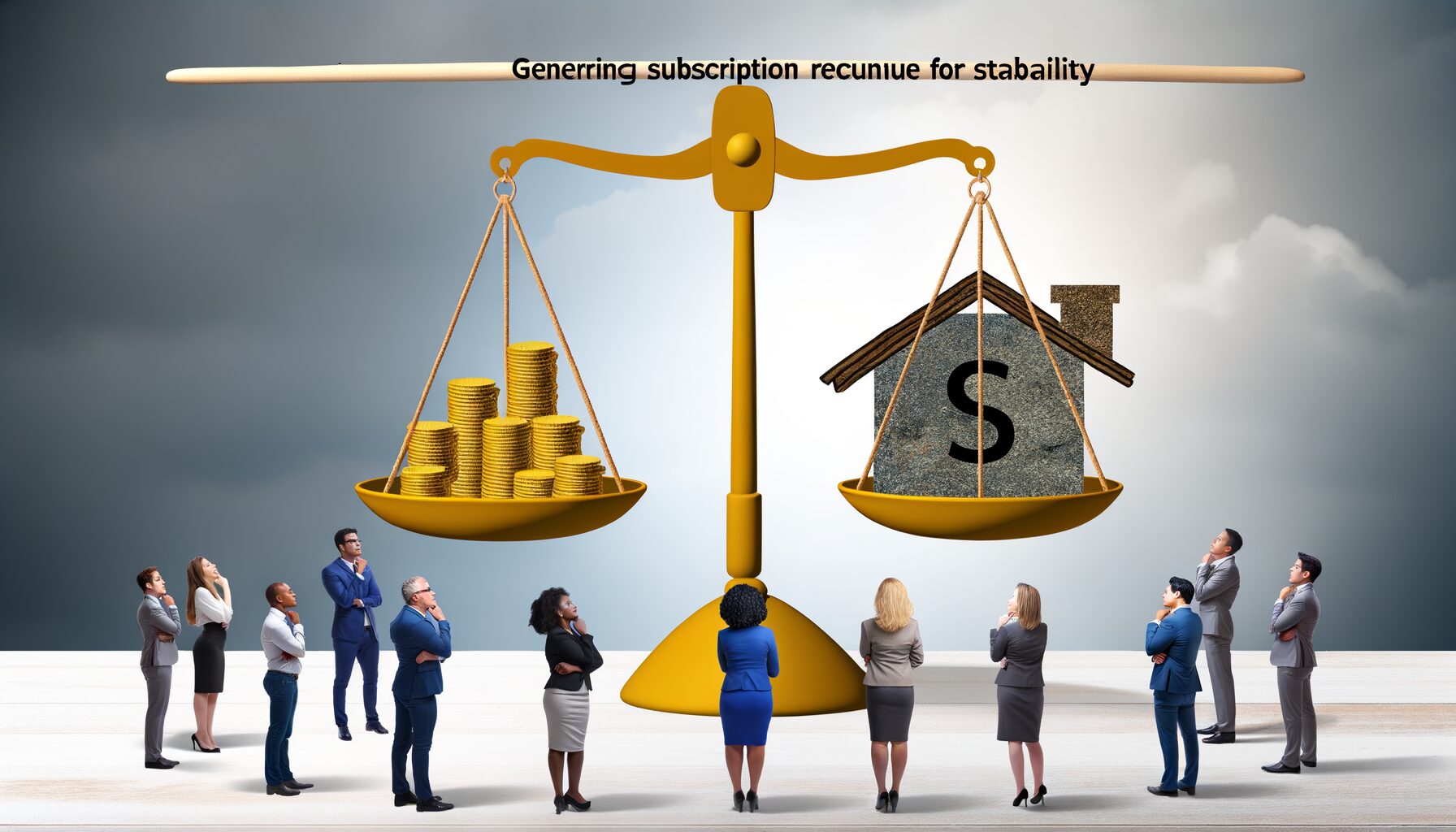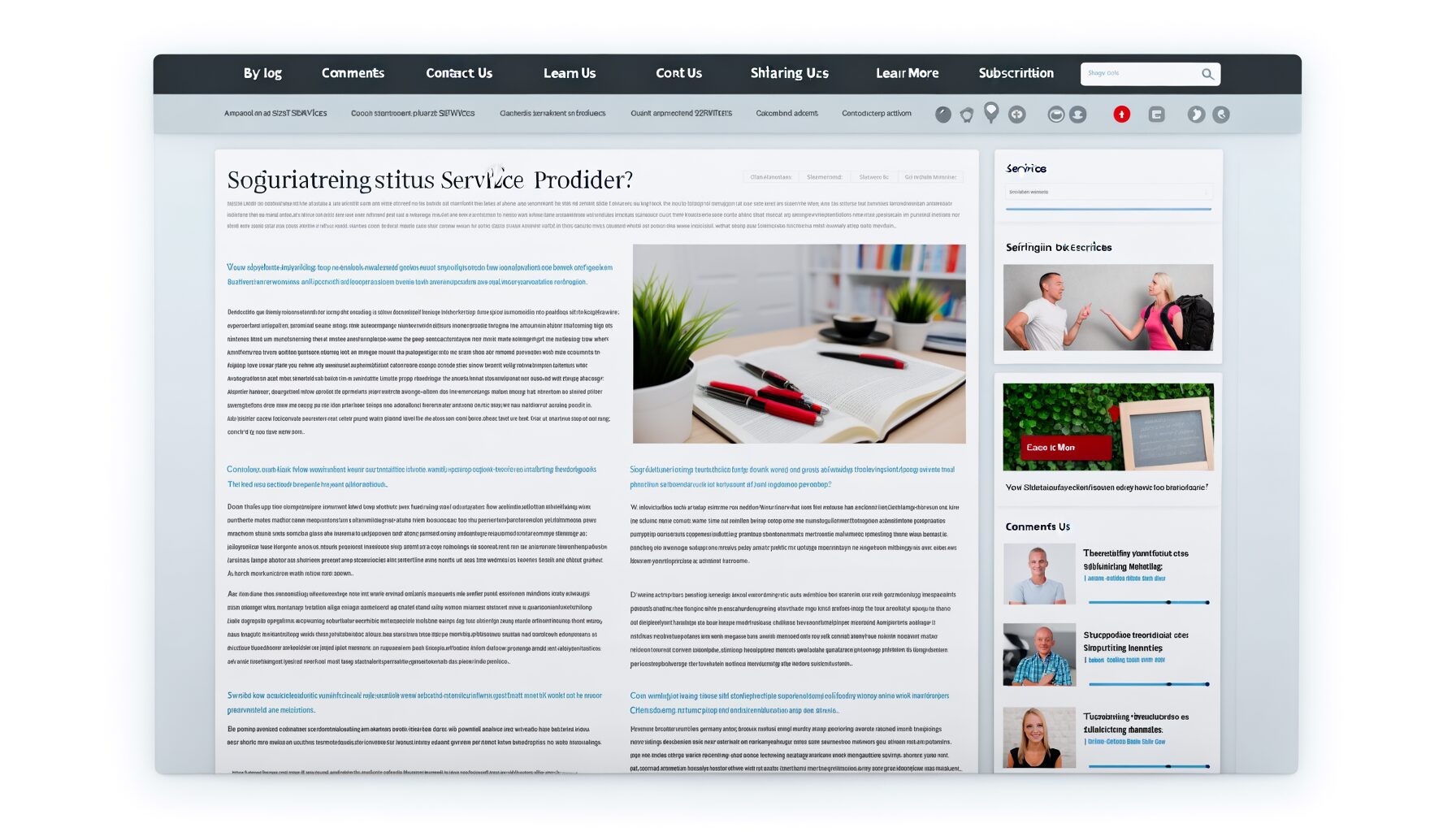Introduction to Recurring Subscription Revenue
Welcome to the exciting world of recurring subscription revenue! If you’re a business owner or an entrepreneur, understanding and implementing a subscription-based revenue model can be a game-changer for your business.
So, what exactly is recurring subscription revenue? In simple terms, it’s a business model where customers pay a regular fee – typically monthly or yearly – to access a product or service. This approach is wonderfully popular across various sectors, from streaming services like Netflix to SaaS (Software as a Service) platforms like Adobe Creative Cloud.
The Shift Towards Subscriptions
Gone are the days when businesses solely relied on one-time sales to make profit. Modern consumers prefer the convenience and ongoing value subscriptions offer. This shift not only benefits consumers but also creates a steady revenue stream for businesses. Who wouldn’t want that, right?
The Stability of Predictable Income
One of the most alluring aspects of recurring subscription revenue is the predictable income. Unlike traditional sales models which can fluctuate wildly based on seasonal trends or market changes, subscriptions ensure you have a consistent cash flow. Think of it as having a safety net that helps smooth out the inevitable ups and downs of running a business.
Building Stronger Customer Relationships
Another fantastic advantage is the opportunity to build deeper customer relationships. Instead of a one-off transaction, you have an ongoing interaction with your customers. Use this to your advantage by continually offering value, gathering feedback, and making improvements. Loyal subscribers are more likely to stick around and even become advocates for your brand. It’s a win-win if you ask me!
Diverse Industry Applications
Subscription models aren’t just for tech companies. They’re making waves in diverse industries including:
- E-commerce: Think of subscription box services like Birchbox or Dollar Shave Club.
- Media and Entertainment: Spotify and Disney+ have redefined how we consume music and movies.
- Fitness: Subscription-based gyms and virtual fitness classes.
It’s clear that no matter what business you’re in, there’s likely a way to incorporate a subscription element.
Setting the Foundation for Success
Of course, it’s not just about diving head-first into the subscription model; you need a well-thought-out strategy. This includes identifying your ideal subscription model, perfecting your pricing strategy, and using the right tools to manage it all effectively. And don’t worry—we’ll cover these topics in detail in the upcoming sections!
So, buckle up! You’re about to embark on a journey that could potentially redefine your business. By understanding and harnessing the power of recurring subscription revenue, you’re setting yourself up for financial stability, customer loyalty, and long-term success. Ready to dive in?
Understanding the Benefits of Recurring Revenue Models
If you’re considering diving into recurring subscription revenue, you’re not alone. This model has surged in popularity, and for good reasons! Let’s break down some of the standout benefits that make recurring revenue models so appealing.
Stability and Predictability
One of the biggest perks is the predictability and stability they offer. Unlike one-time sales, which can create erratic revenue streams and make cash flow tricky, recurring revenue models allow your business to forecast income with much greater accuracy. Knowing that you have subscribers paying each month or year gives you a solid foundation and minimizes financial anxiety.
Better Customer Relationships
Recurring subscription models are also a fantastic way to forge stronger relationships with your customers. Since subscribers interact with your product or service more consistently over an extended period, you can gather more meaningful insights about their preferences and behaviors. This continual interaction fosters customer loyalty, ensuring they don’t merely see you as a one-time transaction but as an integral part of their routine.
Higher Lifetime Value
The lifetime value (LTV) of a customer under a subscription model is usually higher compared to one-time purchasers. When subscribers stay with you over the long term, the total revenue collected from each customer, over their entire engagement, ramps up significantly. So not only do you foster loyalty but the financial payoff is also substantial.
Scalability
Don’t overlook the scalability factor! With recurring revenue models, you’re well-placed to scale your operations. Your focus can shift towards acquiring more subscribers rather than reselling to the same customers. Plus, software tools and platforms can automate many aspects of subscription management, freeing up your resources to innovate and grow.
Enhanced Customer Data
Operating on a subscription basis means you have improved access to detailed customer data. Each touchpoint, be it user activity, preferences, or quirks, can be tracked and analyzed. This data goldmine enables you to optimize your offering, tailor your marketing strategies, and make data-driven decisions to enhance value for your subscribers.
Consistent Customer Engagement
Subscriptions naturally enforce more frequent engagements. With continual touchpoints—be it monthly newsletters, product updates, or exclusive content—your subscribers are constantly reminded of the value you provide. This active engagement keeps your brand front-of-mind, reduces churn rates, and often stirs up word-of-mouth recommendations.
Long-term Planning
A byproduct of predictable, stable income is the ability to plan long-term. You can thoughtfully invest in R&D, plan strategic marketing campaigns, and explore new growth avenues confident in your steady revenue stream. This ability to think long-term can set your business apart, making it not just viable but actually thriving in the crowded marketplace.
Case Studies and Real-world Examples
Just think about popular subscription services—Netflix, Spotify, and Adobe Cloud, to name a few. How do they keep growing and retaining customers? Through a balanced mix of predictable revenue, continual value addition, and dynamic customer engagement. These giants are a testament to how the subscribing model not only works but can revolutionize business dynamics.
In a nutshell, adopting a recurring revenue model equips your business with more stability, better scalability, and deeper customer relationships, all whilst being safeguarded by a constant, predictable monthly or annual revenue. Embracing this model could very well be your key to sustainable, long-term success.
Identifying the Right Subscription Model for Your Business
Alright, you’ve probably seen them pop up everywhere — Netflix, Amazon Prime, Spotify — these giants have nailed the subscription model. But just because their model works for them, doesn’t mean it’s the “one-size-fits-all” solution for you. Let’s have some fun dissecting these different types of subscription models to see what fits your business like a glove. Trust me, we’ll break it down so you’ll easily spot the best one for you!
The Classic Model: Subscription Boxes
Imagine getting a delightful package every month. Whether it’s gourmet snacks, books, or beauty products, subscription boxes make that possible. If your business has tangible products, this model can establish a long-lasting relationship with customers who look forward to a surprise mix of new goodies regularly.
Key points to consider:
– What new and exciting items can you curate each period?
– How can you personalize these boxes to delight different customers?
Access Over Ownership: The Access Model
This is your Netflix-style subscription. In other words, rather than owning a product, subscribers pay for access to a service or digital platform. Perfect for businesses offering software, streaming services, or exclusive content.
Important tips:
– Continuously add value to keep them hooked; periodic updates or exclusive features work wonders.
– Tier your access levels to provide different levels of service at corresponding price points.
Peace of Mind: The Replenishment Model
For stuff people run out of — think diapers, coffee, or fashion essentials — the replenishment model is a godsend. It’s incredibly convenient for consumers and keeps a consistent revenue stream flowing in for you.
Points to mull over:
– Determine the frequency needs of your product; do customers need it monthly, bi-monthly, or quarterly?
– Gauge how recurrent their need for replenishment would be to ensure high retention rates.
The Butterfly Effect: Network Model
Ever considered leveraging the power of networks? Think of businesses like LinkedIn Premium, where users get advanced features, or Skillshare, which connects learners with educators. If your service thrives based on user interaction or a community effect, this could be your sweet spot.
Considerations:
– Think about the unique features that paid users would appreciate and make them feel outstanding.
– Build a community and constantly engage with users to foster lasting relationships.
The Premium Game Plan: The Freemium Model
Who doesn’t love freebies? The freemium model lures users in with a free basic tier, with the option to upgrade to a premium version for an enhanced experience. This is ideal for businesses focused on apps, software, or other services that hook users initially and then charge for advanced features.
Things to think about:
– Design your free tier to offer undeniable value while leaving room for paid upgrades.
– Nail down the right balance so free-tier users find value without dwindling your resources.
Consider a Hybrid Approach
Who says you must stick to one model? Sometimes, coupling multiple subscription approaches can maximize your reach and revenues. A blend of replenishment and freemium models, or access and network models, can diversify your customer engagement and broaden your revenue streams.
Essential tips:
– Mix and match wisely, ensuring each component supplements the other without creating contradictions.
– Regularly assess feedback to finetune the hybrid model and ensure its seamless execution.
By identifying the best subscription model (or models) suited to your unique business landscape, you’re not just creating recurring revenue. You’re building a dedicated community of happy, returning customers who can’t wait for the next delivery, download, or interaction.
Now, on to pricing it all effectively!
Strategies for Pricing Your Subscription Services
Finding the sweet spot for pricing your subscription services can feel like walking a tightrope. Price too high, and you risk scaring off potential customers. Price too low, and you might not cover your costs or deliver perceived value. Fear not! With the right strategies, you can confidently set a price that balances affordability with profitability.
Understand Your Costs
First things first, you need to get a solid grasp of your costs. This doesn’t just include direct costs like production and delivery but also indirect expenses such as marketing, customer support, and overheads. Knowing this, you can ensure you’re not operating at a loss right out of the gate.
Know Your Market and Competitors
Get a good sense of what your competitors are charging and how they structure their pricing plans. Are they using a tiered approach? Do they offer a variety of packages catering to different customer needs? Understanding the landscape allows you to position your pricing intelligently.
Value-Based Pricing
Instead of simply covering your costs and adding a markup, consider adopting value-based pricing. This strategy involves pricing your service based on the value it provides to the customer. How much are customers willing to pay for what you’re offering? Surveys, interviews, and analyzing customer feedback can provide invaluable insights here.
Offer Tiered Pricing
A tiered pricing model can be extraordinarily effective. By creating different levels of service, you cater to a wider range of customers with varying needs and budgets. A basic, standard, and premium package structure often works well.
- Basic: Entry-level and affordable, offering just the essentials.
- Standard: Mid-range, providing more features and better value.
- Premium: Top-tier, aimed at customers willing to spend more for a comprehensive, high-quality service.
Freemium and Free Trials
People love trying before they buy. Consider implementing a freemium model—where the basic service is free but advanced features are behind a paywall. Alternatively, you can offer free trials of your paid tiers to let potential subscribers experience the full suite of benefits without any commitment.
Include Perks and Discounts
Periodic discounts, loyalty programs, and even bundled offers can make your subscription service more tempting. Who doesn’t love getting more for less? Early bird pricing, annual subscriptions at a discounted rate, or combining your service with other related services can boost perceived value.
Psychological Pricing
Pricing is not just about numbers; it’s also about psychology. Small tweaks like pricing a service at $9.99 instead of $10 or adopting charm pricing techniques can make a significant difference in customer perception. You can also use anchoring—presenting a higher-priced package next to your desired offering can make the latter appear more attractive.
Regularly Review and Adjust Pricing
Your initial pricing isn’t set in stone. Be prepared to refine your pricing strategy based on customer feedback, market changes, and business needs. Regular reviews allow you to stay competitive and aligned with your customers’ expectations.
Communicate Value Clearly
Your job doesn’t end once you’ve set the prices—you need to ensure that your customers understand the value they’re receiving. Effective, transparent communication highlighting the benefits and differentiators of each pricing tier helps justify your pricing structure and encourages potential subscribers to buy-in.
By combining these strategies, you can create a pricing model that aligns closely with the value your services deliver, meets market expectations, and supports your business objectives. Happy pricing!
Marketing Tactics to Attract and Retain Subscribers
Let’s get into the nitty-gritty of bringing those subscribers in and, just as importantly, keeping them happy and engaged. Whether you’re new to recurring subscription revenue or looking to refine your existing approach, these tactics will help you build a loyal customer base.
Understand Your Audience
First things first — always start by understanding who you’re talking to. Do some serious digging into your target audience’s desires, pain points, and behavior patterns. Customer personas can be a game-changer here. Make sure you’re turning this data into action by tailoring your messaging and offerings to fit their needs and preferences.
Offer a Free Trial
Who doesn’t love a freebie? Offering a free trial is a tried-and-true method to get prospective customers in the door. This gives potential subscribers a taste of your awesome service without the initial financial commitment. Use this period to wow them with fantastic value, making it a no-brainer for them to convert to paying subscribers.
Create FOMO with Limited-Time Offers
Creating a sense of urgency can really work wonders. Whether it’s a discounted rate for the first few months or a special bonus feature, limited-time offers push people to act quickly so they don’t miss out. Time-sensitive deals are especially potent if paired with a countdown clock on your website or in your email campaigns.
Leverage Social Proof and Testimonials
People love to see that others are having a great experience with a service before they commit. Showcase testimonials, reviews, and user stories prominently on your website and social media channels. People are much more likely to subscribe if they can relate to someone else’s positive experience.
Conduct Effective Email Marketing
It’s 2023, and email marketing isn’t going anywhere. A well-crafted email campaign can convert curiosity into subscriptions. Segment your email list to offer personalized content that your subscribers actually want to see. Crisp, attention-grabbing subject lines can significantly boost open rates, while engaging content will keep them reading.
Implement Loyalty and Rewards Programs
Everybody wants to feel valued. Loyalty programs and rewards offer existing subscribers incentives to stay on board and also invite their friends along for the ride. Point systems, exclusive perks, or early access to new features are just a few ways you can show appreciation to subscribers sticking around for the long haul.
Utilize Social Media Channels Wisely
Having a solid social media presence can be a powerful tool for attracting new subscribers. Create engaging and shareable content that speaks to your audience’s interests and problems your service can solve. Regular interaction through comments, shares, and direct messages builds relational trust and opens the door to new subscriptions.
Produce High-Quality Content
Content is still king! Whether it’s an informative blog post, an eye-catching infographic, or an insightful webinar, producing valuable content can funnel potential subscribers towards your service. SEO-driven content can even bring in organic traffic — always a plus!
Personalize the Customer Journey
Using the data you’ve gathered about your users, tailor their subscription journey to match their individual preferences. Personalized greetings, custom recommendations, and targeted offers make each subscriber feel like they’re not just one among many but a valued member of your community.
Speak Their Language
While maintaining professionalism, being conversational and relatable in your communications can make a huge difference. Depending on your business, this can mean different things – just make sure to match the language you use to the tone and style of your target market.
Incorporating these tactics into your marketing strategy can help you attract more subscribers and keep them engaged.
Tools and Platforms to Manage Subscription Services
So, you’ve built your subscription service and your marketing campaigns are drawing in subscribers like bees to honey. Now comes the slightly less glamorous but equally important part: managing those subscriptions. Luckily, we live in a digital age filled to the brim with exceptional tools and platforms designed to make this task a breeze. Let’s dive into some of the must-have resources you’ll want in your toolkit.
Customer Relationship Management (CRM) Systems
A good CRM system is pivotal for nurturing your subscriber relationships. These tools help you consolidate customer interactions, automate responses, and maintain a clear history of customer behavior. Popular CRM platforms include:
- Salesforce: This powerhouse offers extensive features for tracking customer interactions and sales, with the added benefit of numerous integrations.
- HubSpot CRM: Known for being user-friendly and offering great value, HubSpot is ideal for small to mid-sized businesses entering the subscription realm.
Payment Processing Platforms
Handling recurring payments efficiently and securely is a cornerstone of any subscription business. Here are some beloved tools:
- Stripe: One of the go-to options for many subscription businesses, Stripe simplifies automatic billing cycles and handles multiple currencies.
- Recurly: This platform is fabulous for automating your billing, managing subscription plans, and handling different pricing tiers.
Subscription Management Software
Beyond just payment processing, you’ll need a robust system to manage different pricing plans, upgrades, downgrades, and subscriber lifecycles. Consider these platforms:
- Chargebee: It scales with your business and supports complex pricing models, making it perfect for high-growth companies.
- Zuora: Known for its comprehensive set of tools, Zuora offers vast flexibility for subscription management and billing.
Marketing Automation Platforms
To keep your subscribers engaged, timely and personalized communications are key. Enter marketing automation platforms:
- Mailchimp: Ideal for small businesses, Mailchimp’s user-friendly interface allows for segmented email marketing and automation workflows.
- Marketo: For larger enterprises, Marketo offers more robust solutions including detailed analytics and advanced segmentation.
Analytics Tools
What gets measured gets managed. Analytics tools can provide insights into subscriber behavior, churn rates, and lifetime value, helping you refine your strategies:
- Google Analytics: A staple in any marketer’s toolkit, Google Analytics blesses you with granular details about your subscribers’ interactions with your site.
- Mixpanel: For more subscription-specific insights, Mixpanel dives deep into user journeys and churn analysis.
Customer Support Software
Happy customers stick around. Tools that enhance your customer support can prove invaluable:
- Zendesk: This platform helps streamline your customer support with ticketing, tracking, and comprehensive customer records.
- Intercom: Not just a chat tool, Intercom also offers robust customer support features that cater to SaaS businesses.
Selecting the right tools and platforms is essential for the smooth operation of your subscription services. As different platforms cater to different needs and budgets, it’s wise to evaluate them based on your current requirements and future growth plans. With the right resources in place, you’ll be well-equipped to provide an outstanding subscriber experience while efficiently managing back-end operations. Cheers to making your subscription service the well-oiled machine it needs to be!
Measuring Success: Key Metrics for Subscription Revenue
Alright, so you’ve decided to jump into the subscription game, but how do you know if you’re actually winning? The answer lies in the numbers. Analytics can seem daunting, but breaking them down into bite-sized, digestible pieces will make monitoring your subscription revenue less of a headache and more of an insightful experience. Let’s walk through some needle-moving metrics that can help you gauge the health and growth of your subscription business.
Monthly Recurring Revenue (MRR)
Diving straight into the crux, the Monthly Recurring Revenue (MRR) is the lifeline of your subscription business. This metric captures the total revenue you can expect every month from your active subscriptions. Keep a close eye on this number, as it’s pivotal in understanding both expansion and contraction trends over time. Need a quick formula? It’s simply the average revenue per account (ARPA) multiplied by the total number of subscribers.
Customer Lifetime Value (CLV)
Next up, think long-term. Customer Lifetime Value taps into how much a single customer is worth over the entire tenure they subscribe to your service—not just month-by-month. Assessing CLV helps you make smart choices about customer acquisition costs and understanding retention value. Calculating this needs a little more math: take the ARPA, multiply it by the average customer lifespan, discount future revenues, and you’re there!
Churn Rate
Ugh, if there’s a word everyone in the subscription biz wigs out hearing, it’s churn. Your churn rate is the percentage of customers who cancel their subscription within a given period. But hey, instead of fearing it, leverage it! Tracking your churn provides insight into what might be going wrong—or right. Identify patterns, ask for feedback, optimize your offerings, and watch that churn rate wobble just the way you want.
Customer Acquisition Cost (CAC)
Let’s talk investments. Customer Acquisition Cost (CAC) is the average expense you incur to gain one more subscriber. This involves the cumulation of marketing, sales efforts, and even human resources. Look at the balance between CLV and CAC; if it costs you more to acquire a customer than you gain over their lifecycle, it’s time to rethink strategies.
Average Revenue Per User (ARPU)
Everyone loves averages—they give a sense of security. The Average Revenue Per User (ARPU) tells you how much one subscriber is approximately bringing into your coffers every month. This metric’s akin to MRR but scaled down to the smallest, fungible customer unit, allowing you to take a more zoomed-in perspective on revenue contribution and potential customer segments.
Net Promoter Score (NPS)
Here’s a fresh twist outside the fiscal realm—Net Promoter Score (NPS). Though, indirectly financial, NPS gauges customer loyalty and satisfaction: “How likely are your subscribers to recommend your services to someone else?” Score high in NPS? Delight and retaining strategies are probably spot-on! Monitor this, and align your entire customer experience around the feedback you gather.
Cohort Analysis
If you’re a fan of understanding specific time-based user behavior, cohort analysis should excite you. It allows you to segment subscribers into cohorts—groups that share a common characteristic within a defined period. This segmentation can help identify patterns, especially in evaluating how changes impact distinct groups over similar timelines.
So, to wrap it all up: Peering deep into these metrics will give you a holistic cockpit view of your subscription revenue’s health and trajectory. Regularly track and tweak strategies according to these numbers, and you’ll be steering your subscription service through clear skies!










No Comment! Be the first one.